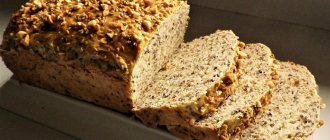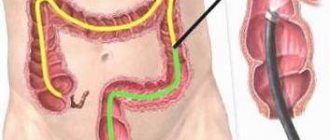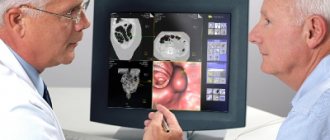Full text of the article:
With intestinal diseases, it is especially important to pay attention to nutrition. Intestinal diseases often cause a deficiency of nutrients in the body, as they disrupt the gastrointestinal tract and interfere with the absorption of nutrients. In addition to proteins and fats, the body may not receive enough vitamins and microelements that are necessary for normal functioning, so it is important to take care to avoid deficiencies. Proper nutrition helps with this.
What should be the diet for gastrointestinal diseases?
The diet for intestinal diseases should not be meager; on the contrary, it will be necessary to include sufficiently high-calorie foods in the diet. If a person’s food absorption process is disrupted, then he usually begins to quickly lose weight, not only fat, but also muscle tissue “melts”. This process must be balanced by increasing the amount of complete protein entering the body (at least 130-140 g).
It is recommended to switch to fractional meals
and eat small meals 5-6 times a day to reduce stress on the intestines. Food will enter the body more evenly, and the body will be able to absorb more nutrients.
IBD and coffee
Although in Russia the number of people who drink coffee is inferior to the number of tea drinkers, the number of residents of our country who drink at least sometimes a cup of coffee is, according to various estimates, 60-75%.
The positive effect of drinking coffee has been proven for several chronic diseases (non-alcoholic fatty liver disease, type 2 diabetes, Parkinson's disease, constipation, etc.). A large 2012 prospective study of more than 400,000 people found a reduction in overall mortality, stroke, and heart disease in people who drank coffee.
Coffee lovers also include patients with IBD. How does coffee affect the intestines? How harmful (or beneficial) is drinking coffee for Crohn's disease and ulcerative colitis?
Coffee has a prebiotic effect, positively influencing the intestinal microbiota, and also has antibacterial activity, reducing the number of E. coli, bacteria of the genus Clostridium and increasing the number of lacto- and bifidobacteria. In addition, a stimulating effect of caffeine on colonic motility and an increase in rectal sphincter tone have been described. A 2014 study found that drinking coffee reduced the risk of developing primary sclerosing cholangitis, which is often associated with IBD.
Coffee consumption does not appear to influence the risk of developing IBD, although a recent meta-analysis showed a trend towards a reduced risk of developing ulcerative colitis with coffee consumption.
Swiss researchers in 2015, surveying 442 patients with IBD, found that 3/4 of respondents regularly drink coffee. Among those who did not drink coffee at all or drank it very rarely, 62% explained their refusal to drink due to worsening symptoms of the disease. This answer was most often given by patients with Crohn's disease - 76.4%. With ulcerative colitis - 44.4%. If we evaluate the effect of coffee on symptoms in all 442 patients, then its negative effect was noted by 45.2% of patients with Crohn's disease and 20.2% with ulcerative colitis.
There have been no other significant studies using laboratory and endoscopic methods to assess disease activity in patients with IBD. Thus, patients with Crohn's disease and ulcerative colitis can drink coffee if it does not worsen symptoms or cause new complaints.
Mineral deficiency
In case of intestinal diseases, the body receives insufficient minerals, but this deficiency can be replenished with the help of dairy products
. Not only do they contain a lot of minerals, but they are also easily absorbed by the body. Dairy products can provide the body with a sufficient amount of phosphorus and calcium, but one must keep in mind that not all dairy products can be well tolerated by the body in case of intestinal diseases. For example, fresh milk may be too “heavy”, and fermented milk products, due to their increased acidity, can irritate the walls of the stomach.
The most neutral and useful product for intestinal diseases is unleavened cottage cheese.
, as well as unsalted and low-fat
cheese
. These products can be an alternative to kefir and yogurt. It is only important that the products are fresh and natural, without additional spices or flavor enhancers.
Therapeutic approaches for widespread ulcerative colitis
From 20% to 40% of patients with ulcerative colitis have X-ray endoscopic signs of disease extending proximally to the left flexure of the colon. This form is classified as total colitis or “pancolitis”. Patients with ulcerative colitis with total damage to the colon have a more aggressive course of the disease with the development of intestinal and extraintestinal complications, a less favorable response to treatment and, therefore, a worse prognosis. This group has the highest surgical activity and mortality. Among patients with total colitis, at least a third will have a chronic continuous course of the disease, when clinical remission is not achieved at all during drug treatment. In addition, if even mild and moderate forms of the disease are not treated prophylactically, then 90% of patients will have repeated exacerbations within a year. Patients with total colitis have an increased risk of developing dysplasia and colon cancer. Thus, the goal of therapy for already widespread colitis will be not only the induction and maintenance of remission, but also the prevention of complications associated with the disease, including malignant neoplasms.
Induction of remission in mild to moderate widespread colitis
Patients with mild to moderate widespread colitis should begin treatment with aminosalicylates. Typically, the first line of therapy is sulfasalazine at a daily dose of 4–6 g/day or mesalazine (Salofalk), to which up to 80% of patients respond by achieving clinical remission or improvement within 4 weeks.
If there is no effect from aminosalicylates within 1–3 weeks or their intolerance, moderate disease activity, they resort to the second line of therapy, namely the use of oral glucocorticoids. Oral prednisolone also shows a dose-dependent effect in the range from 20 mg to 60 mg/day. At the same time, a dose of 60 mg/day is more effective than 40 mg/day, although it is accompanied by an increase in side effects. The maximum dose of prednisolone is maintained until there is clear clinical improvement, and then it is reduced by 5–10 mg weekly to 20 mg/day, then by 2.5 mg per week until complete withdrawal. Prednisolone is taken once in the morning, since there is no increase in the effectiveness of treatment when dividing the daily dose into 2-3 doses. A population-based study examined the outcomes of treatment with systemic corticosteroids immediately after treatment (30 days) and after 1 year [14]. Complete remission after a month of hormonal therapy was observed in 54% of patients, partial in 30%, and no response in 16%. But meta-analyses assessing the effectiveness of current drug therapy for ulcerative colitis show that almost 90% of patients with mild to moderate disease achieve complete clinical remission or partial improvement when treated with glucocorticoids [25, 45]. When prescribing steroids, aminosalicylates are discontinued and the dose of prednisolone is reduced to 20–30 mg per day in order to maintain the clinical and endoscopic effect. Unlike Crohn's disease, hormonal dependence is not common, and therefore, not all patients will need to take immunomodulators. Most patients with ulcerative colitis, after achieving corticosteroid-induced remission, can be maintained with sulfasalazine and mesalazine.
Although existing budesonide formulations are not specifically designed for the treatment of advanced ulcerative colitis, there are studies suggesting the possibility of a favorable outcome in patients in whom systemic steroids are not desirable due to comorbidities. We tested Budenofalk in a small group of patients (21 people) and were convinced of the safety and effectiveness of such therapy. These were elderly patients with hypertension, coronary heart disease, atrial fibrillation, and diabetes mellitus. Budenofalk was prescribed at an initial dose higher than the recommended dose - 15-18 mg/day, but 1-2 weeks after achieving a clinical effect it was reduced to 9 mg/day. The total duration of the course was 8–12 weeks. Treatment was carried out simultaneously with oral aminosalicylates or azathioprine, which were maintained as maintenance therapy.
Treatment of severe and fulminant attacks of ulcerative colitis
Severe or fulminant colitis is considered an “extreme” form of the disease with the threat of life-threatening complications. Such an attack can be a manifestation of ulcerative colitis or occur during the chronic relapsing course of the disease. These patients require hospitalization and vigorous treatment. The intensive management protocol includes colonic rest with total parenteral nutrition, antibiotics, and intravenous corticosteroids.
As a general measure, after hospitalization of the patient, the water and electrolyte balance is restored, the disturbances of which contribute to the development of toxic dilatation. Although the patient may experience intense abdominal pain associated with defecation and frequent, debilitating urges, the use of narcotic analgesics, loperamide and diphenoxylate should be avoided. It is necessary to stop taking medications that the patient was previously receiving, including sulfasalazine and 5-aminosalicylic acid (5-ASA). Due to disturbances in their pharmacokinetics under conditions of accelerated transit, acidic pH and dysbiosis, they will not bring additional effectiveness, but may cause a paradoxical outbreak of activity. Concurrent use of mesalazine or sulfasalazine has, moreover, been associated with loss of response to glucocorticoids. Meeting macro- and micronutrient needs is part of the overall patient management plan. If the patient is able to eat on his own, then it is unlikely that his transfer to enteral or parenteral nutrition is necessary. It is enough to reduce the content of dietary fiber and exclude lactose-containing products if they are intolerant. If there is no other possibility, then total parenteral nutrition is not used to relieve a severe attack, but only to prevent protein-calorie starvation. It is quite difficult to decide the need for antibiotic therapy in febrile patients. Although controlled trials of oral vancomycin, intravenous metronidazole, and ciprofloxacin have not demonstrated therapeutic efficacy, they may be appropriate for septic conditions or ongoing enteric infections. A life-saving measure in the treatment of severe total colitis is the use of corticosteroid hormones. A number of authors suggest oral administration of 60–80 mg prednisolone if there are no problems with gastric emptying, based on the lack of direct clinical comparisons of oral and intravenous administration regimens. However, usually the seriously ill patient is treated intravenously. For this purpose, 100 mg hydrocortisone is administered every 6 hours or 60 mg methylprednisolone is administered once in the morning, which has the advantage of less mineralocorticoid activity and will therefore cause less edema and hypertension. It appears that continuous infusion is preferable to bolus administration. The use of supratherapeutic doses of hormones (methylprednisolone 1 g) used in hematological practice has not proven effective in treating severe attacks of ulcerative colitis. You can expect a decrease in temperature and frequency of bowel movements over several days, and sometimes even overnight. In patients who respond to treatment, the intravenous regimen can be switched to oral therapy after 3 days. In this case, it is necessary to avoid a possible sharp drop in the concentration of steroids in the blood, when, for example, intravenous administration is stopped the evening before, and the oral drug is not used until the morning. Typically, both routes of corticosteroid administration are “crossed” within 12 hours. The rate of reduction in the dose of hormones is regulated depending on the speed of the effect, but, as with moderate forms of ulcerative colitis, the duration of treatment is 10–12 weeks. The use of intravenous glucocorticoids provides a clinical response in 53–81% of patients. A double-blind, randomized trial comparing intravenous hydrocortisone and adrenocorticotropic hormone (ACTH) showed that patients who had previously received steroids responded better to hydrocortisone and those who had not been treated with steroids in the past month responded better to ACTH [26]. Interestingly, there was a positive correlation between the severity of colitis and response to intravenous therapy [27]. Unfortunately, 20–30% of patients with severe colitis will not benefit from intravenous steroids. These patients should be observed in close contact with a surgeon experienced in managing such patients to make a timely decision about surgery. Failure to respond within 7–10 days of intravenous therapy is an indication for cyclosporine or colectomy. It should be noted that cyclosporine monotherapy is also used in cases where a severe attack cannot be treated with intravenous steroids due to intolerance.
Maintaining remission of common ulcerative colitis
Ulcerative colitis is an exacerbating disease that requires two-phase pharmacological therapy: first with induction and then maintenance agents. Aminosalicylates are the most important drugs for achieving both goals. When prescribed, the annual rate of exacerbations is reduced to 30–50% compared to 80% when no maintenance treatment is provided [22]. However, unresolved questions remain: which 5-ASA drugs should be preferred, in what dose and for how long should the patient be treated.
Sulfasalazine maintains remission in 71–88% of patients when given in doses of 1 g to 4 g per day with a dose-dependent effect. A dose of 2 g was chosen as the most balanced between effectiveness and side effects. Mesalazine is a different matter, where high doses are safe. It was found that a dose-dependent effect appears at higher doses - up to 4-5 g/day. This has changed the general approach to choosing the dose of aminosalicylates. If previously, after achieving remission, the dose was reduced, now the standard of treatment has changed. Maintain the same dose of mesalazine for both induction and maintenance of remission. There are also discrepancies regarding the choice of 5-ASA drug. Although a meta-analysis favors sulfasalazine [40], there is no strong evidence that one 5-ASA formula is superior to another in maintenance therapy [35]. Next, the physician and patient must make a choice based on efficacy data, potential side effects, and practical considerations such as compliance and cost. For example, in inducing and maintaining remission of left-sided colitis, rectally administered 5-ASA preparations (suppositories, enemas, Salofalk aerosol) are better than oral ones. But in practice, oral medications (tablets, Salofalk granules) are used more often due to patient preference. The combination of oral and topical 5-ASA drugs demonstrates the greatest preventive effect. In patients with left-sided colitis, exacerbations developed in 64% of cases on maintenance treatment with oral mesalazine and only in 36% receiving a combination of oral mesalazine and 5-ASA enema 4 g 2 times a week [11]. Thus, compliance may be improved by intermittent rectal administration of drugs or by reducing the frequency of oral 5-ASA dosing, for example, twice daily. Recently, a new formula of mesalazine was created based on multi-matrix technology - MMX-mesalazine (the drug is not registered in the Russian Federation), releasing 5-ASA throughout the colon. Its tablet contains 1.2 g of 5-ASA, and the drug is taken once a day, which is convenient for the patient. When comparing MMX-mesalazine at a dose of 2.4 g and 4.8 g of Asakol (the drug is not registered in the Russian Federation), its high effectiveness and tolerability were confirmed [21]. There is always a transition period between inductive glucocorticoid therapy and maintenance treatment with aminosalicylates. In practice, most patients requiring exacerbation with steroids will also require high doses of mesalazine to maintain remission (2.5–5 g/day). Only after a year of stable remission is it possible to attempt to reduce the dose to 1.5–2.0 g. No one can say how long maintenance therapy should be carried out. Most experts recommend doing this constantly and continuously. However, in a patient with a mild episode or infrequent mild exacerbations, observation without long-term drug maintenance may be chosen. A number of randomized trials have attempted to answer this question, with conflicting results. A prospective cohort study found that ulcerative colitis worsened in all newly diagnosed patients within 10 years despite supportive treatment, and this occurred in the first 2–3 years. This suggests that maintenance treatment at an adequate dose should continue for at least 2 years. In other studies, taking 5-ASA reduced the frequency of exacerbations in patients with ulcerative colitis even after 2 years of remission [3]. Since aminosalicylates reduce the risk of cancer, this is another good reason to continue long-term maintenance treatment. As the results of epidemiological studies show, mesalazine in a dose of over 1.2 g reduces the risk of developing colorectal cancer by 30–80% [2, 13], and in a dose of over 2.4 g significantly limits the transformation of mild to high-grade dysplasia and cancer [ 44].
Management of glucocorticoid-resistant and dependent patients
The natural course of ulcerative colitis is determined by episodes of exacerbation of the disease, which are then replaced by periods of remission. Glucocorticoids shorten the duration of active manifestations of the disease, but treatment does not always lead to the desired result. When corticosteroid therapy is ineffective, two unfavorable outcomes are noted: glucocorticoid (GC) resistance and dependence. These patients stand out from the general series of patients with inflammatory bowel diseases, since they require alternative therapy, mainly immunosuppressive or even experimental. GK-resistance and GK-dependence occur with almost the same frequency, approaching 20%. However, Crohn's disease is more likely to be GC-dependent, and refractory disease often develops in severe ulcerative colitis. The definition of refractoriness differs significantly in these diseases and within ulcerative colitis itself, depending on the severity and extent of the lesion. According to the European consensus in Prague in 2004, GC-refractory Crohn's disease is established in patients with active disease, despite taking prednisolone 0.75 mg/kg/day for 4 weeks [38]. In a severe attack of ulcerative colitis, the disease is considered refractory much earlier—after 5–7 days of intravenous glucocorticoid therapy due to the risk of developing life-threatening complications [16]. In distal colitis, there is greater tolerance and the disease is assessed as refractory after 6–8 weeks of combined treatment with oral and topical steroids [42]. Greater unanimity in views on GC addiction. Although the definition is established by expert consensus for Crohn's disease, it can equally apply to ulcerative colitis. Hormone-dependent patients are considered to be those who cannot reduce the dose of prednisolone below 10 mg/day after 3 months of treatment without exacerbation of the disease or in whom an exacerbation occurs within the same 3 months after stopping GC therapy [38]. Assessment of GC refractoriness and dependence should be carried out after excluding specific complications of the disease and careful assessment of 3 important parameters - the adequacy of the steroid dose, duration of treatment, means and purpose of therapy. “Pseudo-refractoriness,” for example, in patients with left-sided colitis can be caused by proximal colostasis - with frequent, scanty stools mixed with blood, and these symptoms are easily eliminated with bulk laxatives. The patient may “underreceive” therapy due to low doses of oral aminosalicylates or refusal to use local treatment. In some severe patients with ulcerative colitis, refractoriness is associated with local or generalized cytomegalovirus infection [17]. Not long ago, the term “chronic active” disease was still used to designate patients who could be both GC-dependent and refractory, intolerant of steroids, or remain active despite taking immunomodulators. Today it is recommended to abandon it in order not to cause confusion in the grouping of patients, which requires more precise definitions.
Cyclosporine and infliximab are used in the treatment of GC-resistant colitis with a high degree of evidence.
Steroid-dependent forms of ulcerative colitis
Hormonal dependence reflects the patient’s inability to reduce the dose of GC below a certain value without reactivating the disease. There are various approaches to treating this condition. First of all, an attempt to replace GC with high doses of aminosalicylates orally and rectally. If it is unsuccessful, various immunomodulatory agents are used: azathioprine, 6-mercaptopurine (6-MP), methotrexate, mycophenolate mofetil, infliximab. Due to the delayed action of many of them, there is a certain transition period when the patient continues to receive corticosteroid hormones according to a gentle regimen. For example, if a patient with ulcerative colitis maintains signs of clinical remission on a dose of hormones of 20 mg/day, then usually within 1–1.5 months he can be switched to intermittent intake of prednisolone 40 mg every other day by transferring 1 tablet every 6–10 days ( 5 mg) from one day to the next. The advantages of the intermittent regimen are associated with the possibility of stopping treatment at once without the risk of adrenal insufficiency. During the period of taking GC according to an intermittent regimen, the accumulated signs of hormonal saturation do not regress, but do not increase. Its use as a bridge therapy to immunomodulators is fully justified, as documented by a placebo-controlled study showing a decrease in the frequency of exacerbations during intermittent administration of prednisolone 40 mg every other day in patients with GC dependence and frequent exacerbations of the disease [31]. In the same way, budesonide can be used as an alternative to traditional hormones in patients with GC dependence. In this case, prednisolone is replaced by budesonide after a short time of simultaneous use of both drugs. Budesonide (Budenofalk) is prescribed at a dose of 9 mg per day, when the dose of prednisolone is 30 mg. After this, systemic steroids are reduced and discontinued within a month, leaving budesonide. The calculated dose of budesonide is 3 mg corresponding to 10 mg of prednisolone. A study was conducted that included 120 patients with Crohn's disease who were unable to reduce the dose of prednisolone without exacerbations after 2 attempts. Patients were randomized to receive placebo or budesonide 6 mg/day. Systemic steroids were tapered until discontinuation. As the results of the study showed, by week 13, exacerbations of the disease while taking budesonide developed in 32% of patients, while in the placebo group they were experienced by 65% [9].
Azathioprine, 6-mercaptopurine. A national survey of advisory members of the British Society of Gastroenterology conducted in 1999 found azathioprine to be the most popular agent for maintaining remission in ulcerative colitis [39]. Interestingly, doctors experienced in treating inflammatory bowel disease use higher maintenance doses over the long term and recommend this treatment for patients with less extensive disease. The protocol for the use of azathioprine and 6-MP involves a single dose of the drugs at a dose of 2.0–2.5 mg/kg/day and 1.5 mg/kg/day, respectively. The expected effect occurs on average after 3 months. A complete blood count is performed weekly during the first month of treatment, then once every 2 weeks for another 2 months, and then once every 2–3 months. In case of moderate or severe leukopenia (<3 × 105/l) or thrombocytopenia (<100 × 109/l), the drug is temporarily discontinued and resumed after normalization at a lower, individually selected dose. If possible, it is recommended to determine the level of tipurine methyltransferase to prevent myelosuppression. Azathioprine effectively maintains remission for up to 4 years in many patients [5]. To date, there is no doubt about the GC sparring effect of azathioprine, which probably decreases over time. While the role of azathioprine in inducing remission of ulcerative colitis is questionable, this drug looks quite convincing as a maintenance treatment. After achieving remission, active use of azathioprine for a year reduced the frequency of exacerbations of ulcerative colitis from 59% to 36% [18]. The same trends were observed in other studies, and additional administration of 5-ASA did not increase the effectiveness of maintenance therapy. Azathioprine retained its protective effect even after many years of use.
Methotrexate. There is no evidence base for the use of methotrexate for induction and maintenance treatment of ulcerative colitis. The fact is that the doses successfully used in the treatment of Crohn's disease (25 mg per week intramuscularly) have never been tested in patients with ulcerative colitis in appropriate studies. There is only one report of the use of methotrexate 25 mg/week intramuscularly in 8 patients with ulcerative colitis refractory to GCs and immunomodulators, which was unsuccessful [15]. The latest retrospective study of oral methotrexate (average dose 19.9 mg/week) demonstrates remission in 42% of patients, with remission maintained in 38% for 6 months [10]. It is possible that the results of methotrexate in ulcerative colitis would have been better if the drug had been evaluated with intramuscular and subcutaneous administration. A small pilot study in patients intolerant or resistant to azathioprine is encouraging [30]. In any case, this backup option should be kept in mind. The protocol for the use of methotrexate is borrowed from the experience of treating Crohn's disease. It involves parenteral administration of methotrexate 25 mg/week until remission is achieved, followed by a dose reduction to 15 mg/week as maintenance therapy [1]. The optimal duration of treatment is not known, but is thought to be 3–4 years. When carrying out methotrexate therapy, it is recommended to immediately prescribe folic acid 1–2 mg/day in order to minimize side effects. Patients are warned about the need to protect themselves from pregnancy; the intake of alcohol, myelo- and hepatotoxic drugs is prohibited. Treatment should be temporarily discontinued for leukopenia (< 3 × 109/L), neutropenia (< 1.0 × 109/L), thrombocytopenia (< 100 × 109/L) and a threefold increase in ALT and resumed with great caution after normalization. You should be especially attentive to patients with an increased risk of hepatotoxicity - alcohol abusers, overweight and diabetes mellitus. There is a point of view that azathioprine is preferable in patients with GC dependence, when doses of prednisolone less than 20 mg/day are required to maintain remission, and methotrexate is preferable in case of an outbreak of ulcerative colitis at higher doses of prednisolone. Its effect is faster than azathioprine - 4-8 weeks.
Infliximab. Infliximab can be successfully used not only to induce remission of GC-refractory ulcerative colitis, but also in the management of hormone-dependent forms of the disease. For this purpose, a three-time infusion of infliximab is used at 0, 2 and 6 weeks, followed by maintenance treatment with a single infusion of 5 mg/kg/day every 8 weeks in combination with azathioprine. The evidence base can be provided by two recent randomized, placebo-controlled studies - ACT 1 and ACT 2 [33, 34, 36]. The ACT 1 study included 164 patients with moderate to severe ulcerative colitis who remained active despite taking GCs and tipurines. Infliximab was administered at a dose of 5 mg/kg/day and 10 mg/kg/day at 0, 2, 6 weeks and then at 8-week intervals. By week 30, clinical response was achieved in 52.1% in the infliximab 5 mg/kg/day group, 50.8% in the 10 mg/kg/day group versus 29.8% in the placebo group (p < 0.001). The ACT 2 study randomized 364 patients with ulcerative colitis refractory to at least one standard treatment (5-ASA, GCs, or thiopurines). By week 30, clinical response was achieved in 47.1% in the infliximab 5 mg/kg/day group, 60% in the 10 mg/kg/day group versus 26% in placebo (p < 0.001). Patients treated with infliximab were twice as likely to achieve remission with endoscopic healing and steroid withdrawal.
For questions regarding literature, please contact the editor.
V. G. Rumyantsev , Doctor of Medical Sciences, Professor of the ON-CLINIC MMC , Moscow
Products that regulate bowel function
Various intestinal diseases can be accompanied by different and sometimes even opposite symptoms. For example, a person may suffer from diarrhea or, conversely, suffer from constipation. You can improve intestinal function with the help of certain diets and eating foods that have a laxative effect or weaken intestinal function.
To natural “ laxatives”
” include dried fruits, kefir, legumes, oatmeal and buckwheat.
They are recommended for use by people suffering from periodic constipation, even if it is not caused by intestinal diseases.
Mashed porridges, slimy soups, and foods high in tannin help the stomach work
Nutritionist comments:
For colitis, therapeutic nutrition is a prerequisite for successful treatment.
A properly selected diet and its adherence can quickly get rid of the unpleasant symptoms of the disease. “The right choice of a sanatorium is a significant step towards maintaining and increasing health. “Gorny” is a resort complex that combines the experience and knowledge of Russian and Soviet balneology. The presence of modern medical equipment and innovative installations, the professionalism of the staff and love for their work will serve as the key to extending longevity,” - the head physician of the sanatorium, Alexander Olegovich Karaulov.
Diet No. 4 for intestinal diseases
People who suffer from intestinal diseases have probably heard or even experienced “ diet number 4.”
" This is a special diet that was developed for the treatment and prevention of intestinal diseases. “Diet No. 4” has several more variations, which are indicated by letters. They are based on the same “diet No. 4”, but with certain relaxations; adjustments are made for the severity of the disease and the stage of its cure.
“Diet No. 4” itself is the most gentle for the digestive tract, and therefore the most strict. It provides a diet low in fat and carbohydrates. The diet should not contain fried, smoked, salted or other hot or spicy foods. Only food that has been steamed or boiled and then pureed is allowed.
A common variation of “diet No. 4” is “ diet No. 4c”
” is prescribed to people who have already suffered an acute stage of intestinal disease and are gradually returning to their usual nutritious diet. “Diet No. 4b” helps to restore weight lost due to illness and involves split meals.
2. Symptoms of the disease
Symptoms of colitis may include:
- blood or pus in the stool;
- Diarrhea (diarrhea);
- Abdominal pain;
- Dehydration;
- Heat;
- Pain during bowel movements, urge to have an urgent bowel movement.
For ulcerative colitis
weight loss, skin and eye problems, joint pain, anemia, and blood clots may begin. Ulcerative colitis increases the risk of developing colon cancer.
Visit our Gastroenterology page
Diet No. 4c: do's and don'ts
Diet No. 4c is not as strict as Diet No. 4. It is believed that a person has already suffered from the disease and is ready to return to normal life, but must do this gradually to prevent additional stress on the body. You can eat different food groups, but stick to restrictions.
You can eat dry
biscuits and cookies, day-old bread, but avoid rich and sweet pastries and pies. You can eat soups with vegetable broth, lean meat and fish, baked, boiled or steamed, but you should avoid sausages and anything fried. The same applies to egg dishes: the diet may include steamed omelettes and protein dishes, but there should be no raw, hard-boiled or scrambled eggs. It is permissible to eat crumbly porridges made from tender cereals and small pasta, as well as boiled vegetables, but they must be cooked in water or with a minimum amount of oil.
Prohibited
dairy and sweet cereals, raw vegetables, large types of pasta, some coarse cereals, fruits and berries with high acidity, whole milk and fermented milk products, sweet carbonated drinks, strong tea, coffee and alcohol, vegetable and vegetable oil. You can replace all these products with more “gentle” analogues: bake apples for sweets or choose fruits with a delicate texture, consume milk only as additives to other dishes, replace fermented milk products with non-acidic cottage cheese or curd paste, drink weak tea or rosehip decoction, you can allow Add a little natural butter to your dishes.
3.Diagnostics, treatment and nutrition
Diagnosis of ulcerative colitis
Various procedures and medical tests are used to diagnose ulcerative colitis. In addition to studying the medical history and general examination, one or more of the following procedures may be required:
- Endoscopy, including colonoscopy;
- Blood analysis;
- Stool analysis;
- X-ray examination.
Treatment of ulcerative colitis
Treatment for colitis can be done with medications, dietary changes, or surgery. Although treatment does not always completely cure colitis, in most cases it allows a person to lead a normal life and feel comfortable.
It is important to consult a doctor at the very first signs of colitis. If diarrhea or bleeding is severe, hospitalization may be necessary to prevent dehydration and manage other symptoms of colitis.
Drug treatment for colitis may include sulfa drugs, corticosteroids, immunosuppressive drugs, and antibiotics, which will help reduce inflammation in the intestines and ultimately alleviate the symptoms of colitis.
Nutrition for ulcerative colitis
The appearance of ulcerative colitis is not associated with the consumption of any foods. But if the disease has already begun and is in the acute phase, certain foods can intensify symptoms and worsen the patient’s well-being. Therefore, the doctor may recommend a special diet for colitis, depending on what symptoms accompany the disease. You may also need to take vitamins and nutritional supplements.
About our clinic Chistye Prudy metro station Medintercom page!
4. Surgical treatment of colitis
Surgery to treat colitis may be necessary if other treatments do not help, or the disease progresses very quickly and is accompanied by serious complications.
During surgery, the entire colon or some affected areas may be removed. If the entire colon is removed, the procedure usually involves making a hole in the abdominal wall to expose the tip of the small intestine (a procedure called a permanent ileostomy). Food waste comes out through this opening and is collected in an external “bag” attached in a special way to the stoma. You will have to wear it constantly.
The ileal anastomotic anal pouch, or pelvic pouch, is a new device that does not require a permanent stoma. In this case, during surgery, the colon and rectum are removed, and an internal pouch, or reservoir, is formed in the small intestine, which will act as a new intestine. This sac connects to the anus. Surgery is usually performed some time after the colon is removed, and a temporary ileostomy is required in between surgeries.
There are other methods of surgical treatment of colitis, which your attending physician will tell you about. All these operations are quite complex and may have certain risks and complications. Therefore, the decision about surgery for colitis should be made after consultation with a good doctor, whose professionalism is beyond doubt.
Papaya
People with Crohn's disease think they have to avoid fruit, but even during a flare-up, tropical fruits like bananas are an easy-to-digest, nutritious option. Mango and papaya are very rich in nutrients and very, very easy to digest. Papaya contains the enzyme papain, which helps your body digest proteins; Containing light oils, this fruit is also rich in both vitamin C and vitamin A with folic acid and potassium. Melon is also a good choice.
Lettuce
A diagnosis of Crohn's disease does not mean the end of the salad treat. As long as diarrhea does not appear, it is possible to enjoy lettuce salad. Also known as Boston Bibb lettuce, a sub-head lettuce variety with tender greens, excellent flavor, a widely available light green lettuce that is much more tender and easily digestible than other salad greens.
Oatmeal
This is comfort food and a great choice. Oatmeal is good both during the period of remission and during the period of mild exacerbation.
Insoluble fiber—a special type of rough plant fiber found in herbs, fruits, vegetables, and nuts—causes water to remain in the intestinal lumen and can cause or worsen diarrhea in people with inflammatory bowel disease. But oatmeal has soluble fiber, which absorbs water on its own and passes more slowly through the digestive tract.









